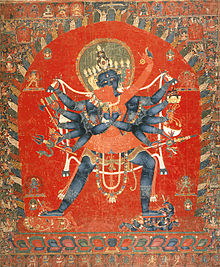- Cakrasaṃvara Tantra
-
The Cakrasaṃvara Tantra, Chinese: 胜乐金刚 shènglè jīngāng; Tibetan: Khorlo Demchog Gyud (Tibetan: འཁོར་ལོ་སྡོམ་པ / བདེ་མཆོག, Wylie: khor lo sdom pa / bde mchog gi rgyud) is considered to be of the mother class of the Anuttara Yoga Tantra in the Indo-Tibetan Vajrayana Buddhist tradition.
The central deity of the mandala, a heruka known as Saṃvara (variants: Saṃvara & Saṃbara) or simply as Śrī Heruka,[1] is one of the principal iṣṭha-devatā, or meditational deities of the Sarma schools of Tibetan Buddhism.
Saṃvara is typically depicted with a blue-coloured body, four faces, and twelve arms, and embracing his consort Vajravarahi (in Chinese 金刚亥母 jīngāng hàimǔ)in the yab-yum position. Other forms of the deity are also known, with varying numbers of limbs. Saṃvara and consort are not to be thought of as two different entities, as an ordinary husband and wife are two different people; in reality, their divine embrace is a metaphor for the union of great bliss and emptiness, which are one and the same essence.
Samvara manifests in a number of forms, including a two-armed form. As one of the principal yidams of the Kagyupa lineage of Tibetan tantric Buddhism, he is most often depicted in this form and in union with the red Wisdom Dakini Dorje Phagmo. In Western meditation texts the name Cakrasamvara or Korlo Demchog is often translated to mean Highest Bliss. Meditation on Korlo Demchog is an advanced practice transmitted by ones lama, and binds the mind of the meditator to enlightenment itself.
See also
- Tantra
- "Amazon.com: The Cakrasamvara Tantra: A Study and Annotated Translation (Treasury of the Buddhist Sciences) (9780975373460): David B. Gray: Books:". http://www.amazon.com/Cakrasamvara-Tantra-Annotated-Translation-Treasury/dp/0975373463. Retrieved 2011-04-12.
Notes
- ^ Gray, David B.; Columbia University. Center for Buddhist Studies; Tibet House (Organization : New York; N.Y.) (2007). The Cakrasamvara Tantra: the discourse of Śrī Heruka (Śrīherukābhidhāna). American Institute of Buddhist Studies at Columbia University. p. 35. ISBN 9780975373460. http://books.google.com/books?id=NBbYAAAAMAAJ. Retrieved 12 April 2011.
Categories:- Yidams
- Buddhist tantras
- Tibetan Buddhist practices
Wikimedia Foundation. 2010.

